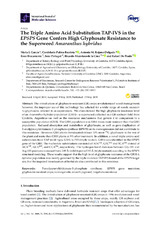Mostrar el registro sencillo del ítem
The Triple Amino Acid Substitution TAP-IVS in the EPSPS Gene Confers High Glyphosate Resistance to the Superweed Amaranthus hybridus
| dc.contributor.author | García, María José | |
| dc.contributor.author | Palma-Bautista, Candelario | |
| dc.contributor.author | Rojano Delgado, Antonia M. | |
| dc.contributor.author | Bracamonte, Enzo Ricardo | |
| dc.contributor.author | Portugal, João | |
| dc.contributor.author | Alcántara-de la Cruz, Ricardo | |
| dc.contributor.author | Prado Amián, Rafael de | |
| dc.date.accessioned | 2019-05-23T12:16:48Z | |
| dc.date.available | 2019-05-23T12:16:48Z | |
| dc.date.issued | 2019 | |
| dc.identifier.uri | http://hdl.handle.net/10396/18623 | |
| dc.description.abstract | The introduction of glyphosate-resistant (GR) crops revolutionized weed management; however, the improper use of this technology has selected for a wide range of weeds resistant to glyphosate, referred to as superweeds. We characterized the high glyphosate resistance level of an Amaranthus hybridus population (GRH)—a superweed collected in a GR-soybean field from Cordoba, Argentina—as well as the resistance mechanisms that govern it in comparison to a susceptible population (GSH). The GRH population was 100.6 times more resistant than the GSH population. Reduced absorption and metabolism of glyphosate, as well as gene duplication of 5-enolpyruvylshikimate-3-phosphate synthase (EPSPS) or its overexpression did not contribute to this resistance. However, GSH plants translocated at least 10% more 14C-glyphosate to the rest of the plant and roots than GRH plants at 9 h after treatment. In addition, a novel triple amino acid substitution from TAP (wild type, GSH) to IVS (triple mutant, GRH) was identified in the EPSPS gene of the GRH. The nucleotide substitutions consisted of ATA102, GTC103 and TCA106 instead of ACA102, GCG103, and CCA106, respectively. The hydrogen bond distances between Gly-101 and Arg-105 positions increased from 2.89 Å (wild type) to 2.93 Å (triple-mutant) according to the EPSPS structural modeling. These results support that the high level of glyphosate resistance of the GRH A. hybridus population was mainly governed by the triple mutation TAP-IVS found of the EPSPS target site, but the impaired translocation of herbicide also contributed in this resistance. | es_ES |
| dc.format.mimetype | application/pdf | es_ES |
| dc.language.iso | eng | es_ES |
| dc.publisher | MDPI | es_ES |
| dc.rights | https://creativecommons.org/licenses/by/4.0/ | es_ES |
| dc.source | International Journal of Molecular Sciences 20(10), 2396 (2019) | es_ES |
| dc.subject | 5-enolpyruvylshikimate-3-phosphate synthase | es_ES |
| dc.subject | EPSPS gene mutation | es_ES |
| dc.subject | Glyphosate-resistant crops | es_ES |
| dc.subject | Nontarget site | es_ES |
| dc.subject | Smooth pigweed | es_ES |
| dc.subject | Target site resistance | es_ES |
| dc.title | The Triple Amino Acid Substitution TAP-IVS in the EPSPS Gene Confers High Glyphosate Resistance to the Superweed Amaranthus hybridus | es_ES |
| dc.type | info:eu-repo/semantics/article | es_ES |
| dc.relation.publisherversion | http://dx.doi.org/10.3390/ijms20102396 | es_ES |
| dc.relation.projectID | Gobierno de España. AGL2016-78944-R | es_ES |
| dc.rights.accessRights | info:eu-repo/semantics/openAccess | es_ES |

